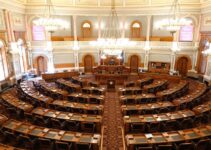Ever wondered how the Canadian federal government's powers are divided? In this quick guide, you'll gain a clear understanding of the federal government's authority and jurisdiction in Canada. From the constitutional framework to the division of powers and federal financial authority, you'll explore the key aspects of the Canadian federal government's powers. Whether you're a student, a newcomer, or simply curious about how the government operates, this concise overview will provide you with a solid grasp of the essential elements that shape the Canadian federal government's powers. So, let's dive in and unravel the intricacies of the federal government's authority in Canada!
Key Takeaways
- The constitutional framework in Canada outlines the distribution of powers between the federal and provincial levels, with constitutional interpretation determining the extent of these powers.
- The Constitution Act, 1867, delineates specific areas of jurisdiction for federal and provincial governments, maintaining a balance between federal and provincial autonomy.
- Provincial autonomy allows decision-making in areas like education and healthcare, while federal oversight ensures national standards and regulations.
- The division of powers promotes a balanced distribution of power and encourages policy innovation and experimentation at the provincial level, while collaborative efforts ensure effective governance across the country.
Constitutional Framework
You will find that the constitutional framework of the Canadian federal government outlines the distribution of powers between the federal and provincial levels. This framework is crucial for understanding how the government operates and how laws are made and enforced. Constitutional interpretation plays a significant role in determining the extent of federal and provincial powers. The division of powers is clearly outlined in the Constitution Act, 1867, with sections dedicated to delineating the specific areas of jurisdiction for each level of government. This allocation of powers is essential for maintaining a balance between federal and provincial autonomy while ensuring the smooth functioning of the country. Federal-provincial relations are deeply influenced by this constitutional framework, as it forms the basis for cooperation, negotiation, and potential areas of conflict between the two levels of government. Understanding the nuances of this framework is vital for comprehending the dynamics of Canadian governance and the delicate interplay between federal and provincial authorities.
Division of Powers
Now, let's talk about the division of powers between the provincial and federal governments in Canada. Understanding the constitutional distribution of powers is essential for grasping how governance functions in the country. This division has a significant impact on the way laws are made and implemented, affecting the lives of Canadians across the nation.
Provincial Vs Federal Powers
The division of powers between the provincial and federal governments in Canada is a fundamental aspect of the country's governance structure. Provincial autonomy allows provinces to make decisions in areas that directly affect their citizens, such as education and healthcare, while federal oversight ensures national standards and regulations are upheld. However, this division can lead to jurisdictional conflicts when both levels of government have interests in the same policy areas, such as environmental protection or natural resource management. In these cases, cooperative federalism becomes crucial, requiring collaboration and negotiation between the federal and provincial governments to find mutually beneficial solutions. This dynamic interplay between provincial and federal powers is essential for maintaining a balance between local autonomy and national cohesion within the Canadian political system.
Constitutional Distribution of Powers
Understanding the constitutional distribution of powers in Canada requires carefully examining the division of powers between the federal and provincial governments. Constitutional interpretation plays a crucial role in determining the specific powers allocated to each level of government. The Constitution Act, 1867, outlines areas of jurisdiction for the federal and provincial governments, and any disputes regarding the division of powers often require constitutional interpretation to resolve. Intergovernmental relations also influence the distribution of powers, as cooperative federalism has become increasingly important in addressing complex issues that require collaboration between different levels of government. The dynamics of intergovernmental relations impact how powers are exercised and shared, making it essential to navigate these relationships effectively. Understanding the constitutional distribution of powers is crucial for maintaining a balanced and effective governance system in Canada.
Impact on Governance
To comprehend the impact on governance resulting from the division of powers, you must consider the intricate interplay between federal and provincial jurisdictions laid out in the Constitution Act, 1867. This division directly impacts democracy and governance effectiveness in Canada in the following ways:
- Balancing Power: The division of powers ensures that neither the federal nor provincial governments hold excessive authority, thus promoting a balanced distribution of power.
- Responsive Governance: It allows for responsive governance tailored to the specific needs and preferences of different regions, fostering greater citizen engagement.
- Policy Innovation: The division encourages policy innovation and experimentation at the provincial level, leading to diverse approaches to governance.
- Challenges and Coordination: It presents challenges in coordinating national policies and programs, requiring collaborative efforts to ensure effective governance across the country.
Federal Legislative Authority
As a citizen of Canada, you should be aware of the federal legislative authority that shapes the laws governing the country. The federal legislative authority in Canada is derived from parliamentary sovereignty, which empowers the federal government to create and enforce federal legislation. This authority is essential in the legislative process, allowing the government to enact federal regulations that impact various aspects of Canadian life.
To provide a clearer understanding of federal legislative authority, let's take a look at the following table:
| Federal Legislative Authority | Description |
|---|---|
| Legislative Process | The procedures and steps involved in creating federal laws. |
| Federal Regulations | Rules and regulations established by the federal government. |
| Parliamentary Sovereignty | The principle that Parliament has supreme legislative power. |
| Federal Legislation | Laws created and enacted by the federal government. |
| Impact on Governance | The influence of federal legislative authority on governance. |
Understanding the federal legislative authority is crucial as it directly impacts the laws that govern the country. This authority sets the stage for the subsequent discussion on executive power.
Transitioning into the subsequent section about 'executive power', it is important to consider how federal legislative authority interacts with the executive branch of the Canadian government.
Executive Power
Now let's talk about the executive power within the Canadian federal government. The Prime Minister holds significant authority in decision-making and policy implementation, while the Cabinet plays a crucial role in shaping and executing government initiatives. Additionally, the Governor General serves as the representative of the Crown and fulfills important ceremonial and constitutional duties.
Prime Minister's Authority
First, you wield executive power as the Prime Minister of Canada, overseeing the implementation and enforcement of federal laws and policies. As the Prime Minister, you are held accountable for your executive responsibilities, which include:
- Setting the political direction and priorities for the government.
- Making key appointments to various governmental positions, such as the Cabinet and senior public servants.
- Representing Canada on the international stage, engaging in diplomatic relations, and negotiating treaties and agreements.
- Leading the Cabinet in making important decisions and shaping government policies.
Your authority as the Prime Minister is crucial in steering the direction of the country and ensuring the effective functioning of the federal government.
Cabinet Decision-Making Process
In your role as the Prime Minister of Canada, you exercise executive power through the Cabinet decision-making process, influencing and shaping government policies. This process involves key principles such as ministerial responsibility, decision accountability, collective responsibility, and policy implementation.
| Principle | Description |
|---|---|
| Ministerial Responsibility | Individual ministers are answerable for the actions of their departments. |
| Decision Accountability | Ministers are responsible for justifying and being accountable for their decisions. |
| Collective Responsibility | All ministers must publicly support the decisions made by the Cabinet. |
| Policy Implementation | Once decisions are made, ministers are responsible for implementing the policies. |
Through these principles, the Cabinet ensures that decisions are made accountably and responsibly, and that policies are implemented effectively to serve the Canadian population.
Role of Governor General
As Prime Minister of Canada, you exercise executive power through the Cabinet decision-making process, influencing and shaping government policies. The Governor General, appointed by the monarch on the advice of the Prime Minister, plays a crucial role in the Canadian federal government. Here's what you need to know about the role of the Governor General:
- Appointment Process: The Governor General is appointed by the monarch based on the Prime Minister's recommendation, and the appointment is typically for a five-year term.
- Ceremonial Duties: The Governor General performs various ceremonial duties, such as the formal opening of Parliament, signing bills into law, and representing Canada at official events and functions.
- Executive Powers: The Governor General holds significant executive powers, including the ability to grant Royal Assent to legislation and the power to dissolve Parliament and call for new elections.
- Constitutional Safeguard: The Governor General serves as a constitutional safeguard, ensuring that the government operates within the parameters of the Constitution.
Federal Financial Powers
When managing federal financial powers, you must understand the intricate balance between the central government and the provinces. The federal government holds the authority for federal budgeting and taxation, allowing it to collect taxes and allocate funds for national programs and services. The federal budgeting process involves the allocation of resources for various government initiatives, such as healthcare, defense, infrastructure, and social programs. It is crucial for the federal government to exercise prudence and transparency in managing public funds to ensure fiscal responsibility.
In addition to federal budgeting, the federal government possesses taxation authority, enabling it to levy taxes on income, goods and services, and corporate profits. This authority provides the government with the necessary resources to fund its operations and fulfill its responsibilities to Canadians. However, it is essential to recognize that the provinces also have their own taxation powers, leading to a complex interplay between federal and provincial taxation systems.
Understanding and navigating the intricacies of federal financial powers is essential for ensuring effective fiscal management and the equitable distribution of resources across the country.
Federal Jurisdiction and International Relations
You should understand the federal government's role in international relations and its jurisdiction over areas such as foreign policy and treaty negotiation. This jurisdiction allows the federal government to effectively represent Canada on the global stage and engage in international agreements and partnerships. Here are four key aspects of the federal government's jurisdiction and role in international relations:
- International Treaties: The federal government has the authority to negotiate and enter into international treaties on behalf of Canada. These treaties cover a wide range of areas such as trade, security, human rights, and environmental protection, among others.
- Diplomatic Immunity: The federal government is responsible for managing diplomatic relations with other countries and international organizations. This includes granting diplomatic immunity to foreign diplomats and ensuring that Canadian diplomats receive the same privileges when serving abroad.
- Foreign Policy Development: The federal government sets and implements Canada's foreign policy, guiding its interactions with other countries and international bodies. This involves promoting Canadian interests, values, and priorities on the global stage.
- International Agreements: The federal government has the authority to negotiate and enter into various international agreements, including those related to security, defense, and global development, contributing to Canada's role in the international community.
Frequently Asked Questions
How Do Federal Government Powers in Canada Impact the Daily Lives of Citizens?
Federal government powers in Canada impact your daily life in significant ways. For instance, they affect the economy by influencing trade policies and financial regulations. Additionally, federal powers play a crucial role in healthcare funding, which impacts the availability and quality of healthcare services you receive. By having control over these areas, the federal government directly shapes the economic and healthcare landscape that you encounter in your daily life.
What Are Some Historical Examples of Disputes Between the Federal and Provincial Governments Over Their Respective Powers?
In the past, historical disputes and constitutional conflicts between the federal and provincial governments have arisen in Canada. These include battles over jurisdictional rights, such as the Persons Case in 1929 and the Patriation of the Constitution in 1982. These conflicts have shaped the division of powers and have had a significant impact on the governance and legal framework of the country.
How Does the Federal Government Exercise Its Authority in Areas Such as Immigration and National Security?
When it comes to immigration policies, the federal government exercises authority through setting regulations, issuing visas, and establishing criteria for entry. In the realm of national security, it implements measures such as border control, intelligence gathering, and law enforcement coordination to ensure the safety of the nation. These actions showcase the federal government's active role in shaping and enforcing policies related to immigration and national security.
What Role Does the Federal Government Play in International Trade and Diplomacy?
In international trade and diplomacy, the federal government plays a crucial role. It negotiates and signs international treaties and trade agreements, representing Canada's interests on the global stage. Through diplomatic missions, it fosters foreign relations and promotes Canadian values and priorities abroad. These efforts help to strengthen economic ties and ensure Canada's voice is heard in international affairs. The federal government's involvement in these areas is essential for shaping Canada's position in the global community.
How Are Decisions Made Within the Federal Government, and How Do They Impact Canadian Citizens?
So, you know how decisions in the federal government can sometimes feel like a game of political chess? Well, the decision-making process involves a complex interplay of powers, historical disputes, and national security concerns. These decisions have a direct impact on Canadian citizens, influencing immigration authority, international trade, and the government's role in diplomacy. It's like a high-stakes game, where the citizens are the pieces being moved around on the board.
Conclusion
As you navigate the intricate web of Canadian federal government powers, remember that each branch plays a vital role in the symphony of governance. Just as a conductor guides an orchestra, the federal government orchestrates the harmony of the nation. Understanding the division of powers, legislative authority, executive power, financial powers, and jurisdiction is like understanding the different instruments and their unique contributions to the grand performance of democracy. Keep exploring, keep learning, and keep appreciating the beauty of governance.



